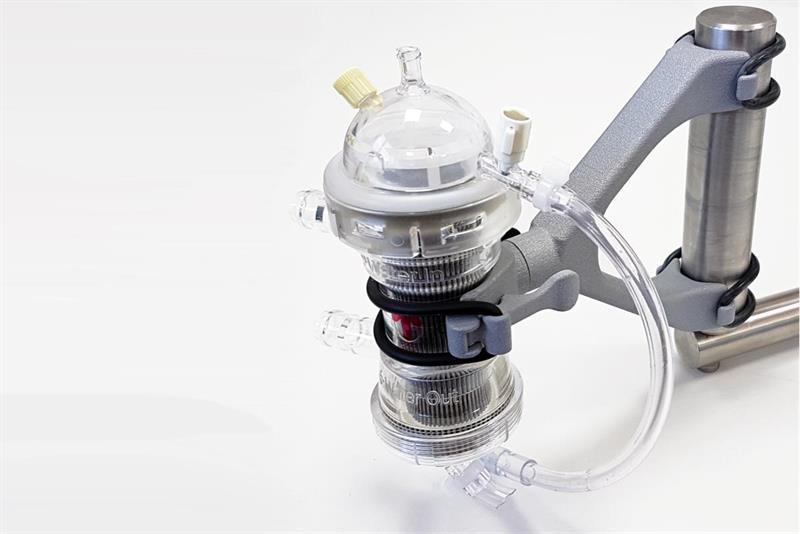Bennett Engineering Design Solutions Creates 3D Printed Cardioplegia Clamps for UK Teaching Hospital
 None of us want to be the one on that operating table as surgeons stop our heart in preparation for a procedure—and we surely don’t want to imagine our loved ones in that position either. It is, however, not an uncommon practice for medical professionals to employ cardioplegia to perform surgery while the heart is in a quieted, bloodless state; in fact, they do this enough that they are constantly refining the tools which they use to make sure that medical professionals are able to offer the best treatment possible.
None of us want to be the one on that operating table as surgeons stop our heart in preparation for a procedure—and we surely don’t want to imagine our loved ones in that position either. It is, however, not an uncommon practice for medical professionals to employ cardioplegia to perform surgery while the heart is in a quieted, bloodless state; in fact, they do this enough that they are constantly refining the tools which they use to make sure that medical professionals are able to offer the best treatment possible.
And now, what’s new in the world of cardiology and that of performing cardioplegia: bespoke tools. They are currently in use at King’s College Hospital Foundation Trust after being developed by Bennett Engineering Design Solutions, an engineering design service also headquartered in the UK that has recently begun to embrace 3D printing. As one of the largest teaching hospitals, King’s College will be introducing their students and doctors not only to the benefits of 3D printing, but to an improvement on the cardioplegia clamp. This follows a successful design already in use from Bennett Engineering in the form of a pressure gauge holder.
 All of this work came about last year as Bennett Engineering was contacted by Michael Whitehorne, head of clinical perfusion science at the college. Exploring the benefits of bespoke solutions, the initial goal was to have the design team create some progressive parts that would support the cardioplegia sets currently being used in their operating rooms.
All of this work came about last year as Bennett Engineering was contacted by Michael Whitehorne, head of clinical perfusion science at the college. Exploring the benefits of bespoke solutions, the initial goal was to have the design team create some progressive parts that would support the cardioplegia sets currently being used in their operating rooms.
“The clamps that were available at the time for holding the cardioplegia set’s heat exchangers which cool down the patient’s blood during cardiac surgery, were no longer meeting the Trust’s requirements,” explained John Bennett, director, Bennett Engineering Design Solutions. “The clamps simply didn’t secure the heat exchangers well enough, they could also be slow and difficult to use.”
It wasn’t just that the Trust was considering using tools made via 3D printing for the sake of using cool new technology. It had come to their attention that their cardioplegia sets needed an overhaul in terms of their design. What they were looking for as they approached the designers at Bennett Engineering was a component that would be able to connect to the standard masts and instrument stands. This is important as heat exchangers must be able to be changed out quickly as emergencies arise, the units have to be cleaned and sterilized with ease, and adjustments must be made seamlessly so that tubes are never under any stress, and blood flow is not stopped.
“The challenge with the design was to create the right geometry to satisfy the Trust’s requirements. The initial prototype needed to be improved to make the changeover quicker. Adjusting the geometry of the catch took two iterations, we also needed to minimise the number of parts required, to ensure ease of use while being aesthetically pleasing too. The clamp for example, features an over center clip finger for the attachment so the removal of the heat exchanger is simple and intuitive to use,” Bennett stated.
“We chose to develop our design using 3D printing as we believed it offered greater flexibility on the design geometry, enabling us to create more organic shapes. This was then followed by the material Alumide, to deliver a tough, highly professional ‘look and feel’ to the end product.”
All of the benefits of 3D printing are on full display here, once again offering the chance to create parts that may not have been viable through another method of fabrication, offering customization, affordability, speed in production, and the chance to use alternative materials like Alumide, comprised of nylon and grey aluminium powder. It is a lightweight yet durable 3D printing material that can also be sealed to allow for both cleaning and sterilizing, making it highly suitable for medical applications.
The team was also able to use more standard parts too for a highly cost-effective solution that included some complex geometries. 3D printing gave them the latitude to make exactly the shapes and resulting objects that they needed to without added expense. For the latest project, the design team also did not have to worry about adding any new manufacturing tools, making the process even easier—and it was completed within eight weeks. They’ve now been using the new 3D printed parts since June. Discuss in the 3D Printed Cardioplegia Clamps forum at 3DPB.com.
[Source: Eureka]Subscribe to Our Email Newsletter
Stay up-to-date on all the latest news from the 3D printing industry and receive information and offers from third party vendors.
You May Also Like
3D Printing Unpeeled: New Arkema Material for HP, Saddle and Macro MEMS
A new Arkema material for MJF is said to reduce costs per part by up to 25% and have an 85% reusability ratio. HP 3D HR PA 12 S has been...
3D Printing News Briefs, January 20, 2024: FDM, LPBF, Underwater 3D Printer, Racing, & More
We’re starting off with a process certification in today’s 3D Printing News Briefs, and then moving on to research about solute trapping, laser powder bed fusion, and then moving on...
3D Printing Webinar and Event Roundup: December 3, 2023
We’ve got plenty of events and webinars coming up for you this week! Quickparts is having a Manufacturing Roadshow, America Makes is holding a Member Town Hall, Stratafest makes two...
Formnext 2023 Day Three: Slam Dunk
I’m high—high on trade show. I’ve met numerous new faces and reconnected with old friends, creating an absolutely wonderful atmosphere. The excitement is palpable over several emerging developments. The high...
































